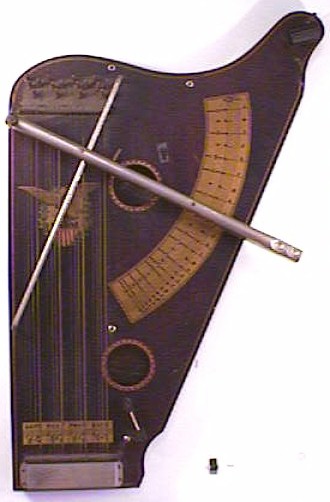
Form 1a
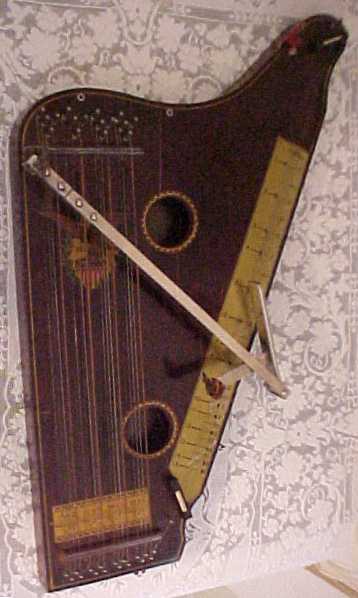
Form 1b
Tremoloa
Here's one of the most distinctive approaches to playing melody on a chord zither. It appeared in response to the rapid increase in popularity of Hawaiian music in the 1920's. The instruction manual is bold enough to say that it "might well be called the Original Hawaiian Instrument," though the Hawaiian steel guitar had already been played for decades. Even the patent plainly states that the instrument "simulates closely the tonal effects of the so-called Hawaiian steel guitar."
There's a single melody string which is under fairly low tension. A sliding (or rolling) weight rests on the string and is positioned by the player to locations marked on the large note label under the string. That position controls the pitch of the string when plucked. The relatively heavy weight actually bounces on the string and alternately raises and lowers its tension a little. Thus the pitch is raised and lowered a little around the desired pitch, and the sound becomes a broad vibrato. In addition, as the weight moves from one played note to the next, the weight stays in contact with the string, and creates a glissando that is reminiscent of the sound of a Hawaiian steel guitar.
The patent for the Tremoloa was granted in 1932 to Harold Finney, a principal in the International Musical Corp. at the time, and John H. Large, an inventor who also received a patent on a form of the Ukelin. The Tremoloa patent was applied for in 1929 and shows Form 1 of the instrument. We could assume that the Tremoloa wasn't available before about 1929.
|
Form 1a |
Form 1b |
In Form 1a, the playing arm is hollow underneath, and it contains a weight that is pivoted at the small pin visible about halfway back. The arm stays at one height, supported by the diagonal bar to the left. As the weight bounces on the string, it moves up and down inside the arm. Barely visible near the end of the arm are two small depressions to receive fingertips of the right hand. The player moves the bar over the note specifed and plucks the string with a thumb pick. (No fair picking melody with the right hand - that one's for the chords!)
Form 1a has also appeared with the two small bridges for the melody string placed perpendicular to the string, rather than angled as shown here. Instruments in Form 1 have appeared with receipts dated as early as 1931.
Apparently doing three things with two hands was a little too much, as the playing mechanism was altered to that of Form 1b. There is now a flexible joint in the arm (marked by the pairs of rivets near the end opposite the pick), so the whole arm, carrying the slide, is now free to bounce up and down as a unit. The slide itself now looks more like an actual guitar slide.
But the main improvement is the attachment of a pick, on a short flexible arm of its own, directly to the slide. Now the melody note label can be marked to show where the pick must be positioned to play the desired note. It took a little math, no doubt, to get the melody note markings positioned correctly, due to the changing distance between the pick and the slide contact point as the arm travels. These modifications brought the playing arm pretty close to the state in which we find it in the common later forms of the Tremoloa.
Form 1 appears with the $35 International Musical Corp soundhole label (no picture available) and with the same soundhole decal that appears on Ukelins labeled International Musical Corp.
|
Form 2a |
Form 2b |
Form 2b |
Form 2 brings in the final innovations. Instead of a slide to set the string's pitch, there's now a nice friction-free roller. It has a pair of felt-lined clips to rest in for travel. And there's an additional short arm to hold the pivot point for the playing arm, and it is spring-loaded into one of two positions. The third picture, above, shows the playing position, and the second picture shows the short arm folded back to fit better into the case or shipping box.
Note that Form 2a has the Oscar Schmidt eagle decal, and it continues to carry the narrow soundhole decal of Form 1 and some of the early Ukelins. It has appeared with the $35 label.
Form 2a has appeared with
Form 2b takes on the soundhole decal with black & cream motif of all the remaining Schmidt zithers up until the end, though on a smaller scale than the other zithers because the soundholes are smaller. The same soundhole decal is used on the smaller soundhole of the Ukelins of that period.
Form 2b has appeared with
Assuming that the factory lot-numbering scheme was applied to these instruments, the same as to the autoharps as documented by Becky Blackley in The Autoharp Book, we can conclude that the Tremoloa was in production at least into the year 1954.
Here's the soundhole label for Form 2a.
There's not much variation in the soundhole labels for Form 2b. The price and paper color differ. The $35 label appears either as shown with "Manufacturers Advertising Co." on one line, or with the words on two lines like the $40 labels.
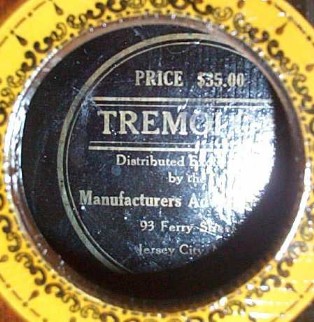
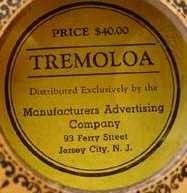
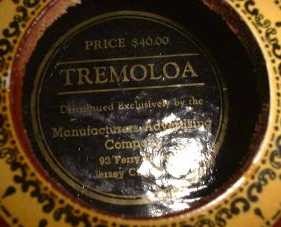
And although the labels say Manufacturers Advertising Company, the instruction manuals generally are labeled Oscar Schmidt-International.
And to finish up, here's a treat - a slightly different form, or an off day in the Ferry Street wood shop?

Recent sale prices: From April to September of 2001, 35 Tremoloas of Form 2 received bids on eBay. The average of the high bids was $53.27. 6 other Tremoloas received no bids.
Drop me a line.
Go back to the Guitar-Zither Clearinghouse, or home.
This page was banged out with Word 97, 6 Jan 02.